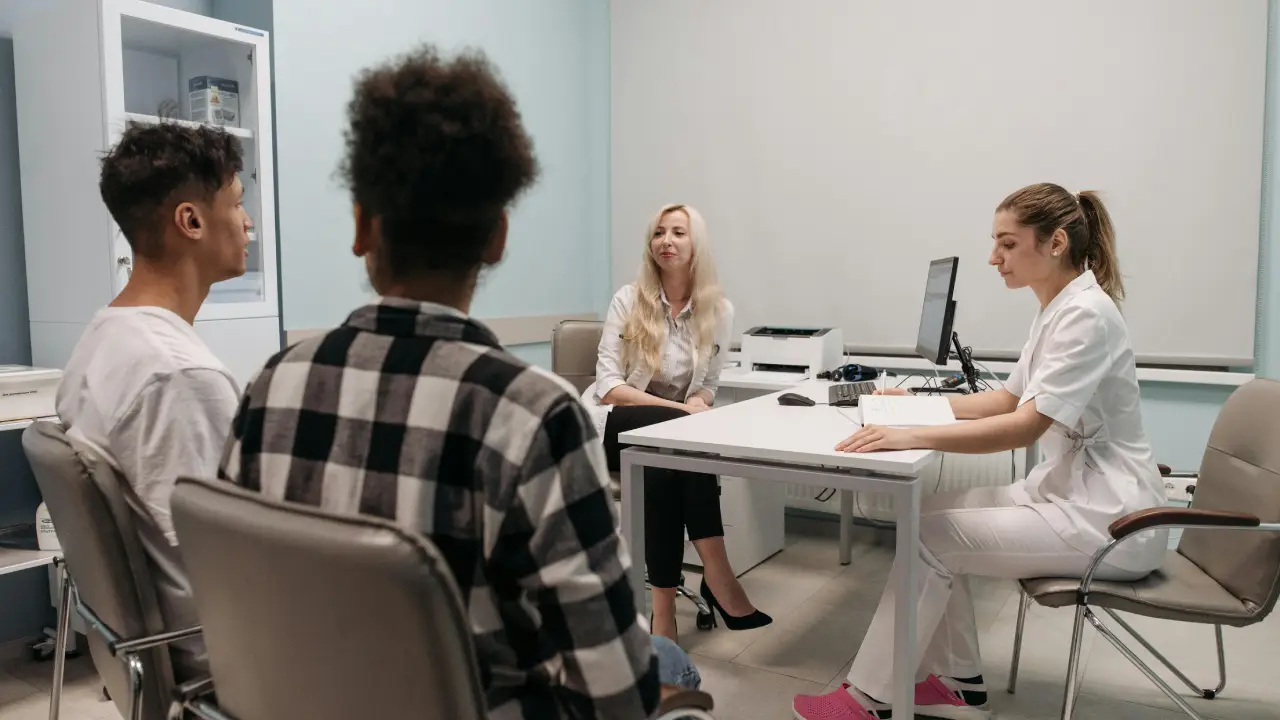If you’ve landed an interview at a hospital, congratulations! Now comes the all-important question: What should you wear? Hospitals are unique environments, and whether you’re applying for a clinical role like nursing or a non-clinical one like administration, your outfit can influence your first impression. In healthcare, where professionalism, cleanliness, and respect are paramount, dressing appropriately can help you convey the right message to potential employers.
General Tips for Hospital Interview Attire
First and foremost, dress conservatively and professionally. Hospitals are settings that require high levels of professionalism, and your attire should reflect this. Stick to neutral colors like navy, black, and gray, which convey a professional tone, and avoid anything too flashy or trendy.
In addition to your outfit, pay close attention to your grooming. Hospitals emphasize cleanliness, so arrive with neatly styled hair, clean nails, and no strong scents. A polished, neat appearance signals respect for the healthcare environment and patients.
Role-Specific Attire Guidelines
In healthcare settings, expectations for interview attire can vary widely based on the position. The following sections provide guidance on what to wear for different types of roles, so you can tailor your outfit accordingly.
For Administrative or Office Roles
Examples of positions: Medical billing specialist, receptionist, healthcare administrator.
For administrative positions, business professional attire is often recommended to reflect the office setting and regular interactions with patients, visitors, and healthcare staff.
- Men: Consider a suit or dress slacks paired with a button-down shirt and tie. A blazer or sports coat can add a formal touch. Dark or neutral colors like navy, gray, and black convey professionalism.
- Women: Professional attire such as slacks or a skirt (knee-length or below) paired with a blouse and blazer is appropriate. Dresses that are conservative in style and fit are also a good choice, especially when paired with a blazer.
- Footwear: Choose closed-toe, low-heeled dress shoes or loafers. Comfort is essential, but avoid sneakers or overly casual flats.
- Accessories: Keep jewelry and accessories minimal. Simple stud earrings, a watch, or a delicate necklace can add polish without being distracting.
For Clinical Roles (e.g., Nurses, Doctors, Therapists)
Examples of positions: Registered nurse, physician, physical therapist, respiratory therapist.
Clinical roles require a balance between professionalism and functionality, reflecting the high standards and responsibilities associated with patient care.
- Men: A suit or dress slacks with a collared shirt and tie is recommended. For a slightly less formal approach, a dress shirt with a blazer can also be appropriate, especially in roles where practical experience will be a focus.
- Women: Consider wearing a tailored pantsuit or a conservative dress with a blazer. Skirts should be knee-length or longer, and blouses should be professional and understated.
- Footwear: Comfortable, closed-toe shoes are essential, especially since you may tour the hospital or clinic. Choose professional-looking flats or low-heeled dress shoes that allow for mobility.
- Accessories: Limit jewelry to small, non-intrusive pieces. Avoid strong fragrances, as hospitals have strict policies to maintain a safe environment for all patients.
If you’re applying for a nursing role specifically, there are additional considerations that can set you apart in an interview. Thoughtful choices can highlight your professionalism and dedication to the nursing field. Check out our guide on what to wear to a nursing interview to make the best impression as a nurse.
For Entry-Level Roles or Internships
Examples of positions: Medical assistant intern, lab technician, entry-level administrative assistant.
For those entering the healthcare field, the attire should be professional yet practical, suitable for both the interview and potentially being in the healthcare setting.
- Men: Dress slacks with a button-down shirt, paired with a blazer if possible. A tie adds formality but may not be necessary depending on the specific role. Stick to neutral tones for a polished appearance.
- Women: Choose slacks or a modest knee-length skirt with a blouse. Adding a cardigan or blazer can give a more professional look without requiring a full suit.
- Footwear: Opt for closed-toe flats or low-heeled shoes that offer comfort, particularly if the interview includes a tour. Avoid overly casual shoes like sneakers or sandals.
- Accessories: Simple accessories are best, such as a watch or small earrings. Keep the look refined, avoiding large or distracting jewelry pieces.
For Technical or IT Roles
Examples of positions: IT support technician, health information technologist, data analyst.
Technical roles in healthcare often allow for a slightly more relaxed dress code while still requiring a professional appearance.
- Men: Dress pants or chinos with a collared shirt, such as a polo or dress shirt, can strike the right balance. A blazer can elevate the look if you’re aiming for a more polished appearance, especially in an interview setting.
- Women: Tailored slacks or a conservative skirt paired with a blouse or professional top works well. Adding a blazer is a good idea, particularly if interviewing for a more senior technical role.
- Footwear: Choose closed-toe dress shoes or loafers, focusing on comfort if the position may require mobility or a tour of the facility.
- Accessories: Limit accessories to minimal items, like a small necklace or stud earrings, to maintain a polished, tech-focused look without appearing too casual.
For Research or Lab Positions
Examples of positions: Lab assistant, clinical researcher, biomedical technician.
Lab and research roles require attire that respects the professionalism of the healthcare environment but also accommodates functionality and comfort, especially if you’ll be in a lab or testing setting.
- Men: A button-down shirt or smart polo with dress slacks or chinos is generally appropriate. Adding a blazer can be beneficial if you’re interviewing for a senior research role, but it’s not necessary in most cases.
- Women: Consider wearing slacks or a knee-length skirt with a blouse. A cardigan or blazer is optional but can enhance professionalism, especially if meeting with senior researchers or administrators.
- Footwear: Closed-toe, non-slip shoes are essential for lab environments. Comfortable loafers or low-heeled shoes are ideal for both practicality and professionalism.
- Accessories: Avoid wearing any dangling or loose jewelry for safety and functionality in the lab setting. Keep accessories simple and understated.
Dress Code by Type of Hospital
The type of hospital or healthcare facility can influence the level of formality in your attire.
Private Hospitals
Private hospitals often maintain stricter dress codes, and candidates are advised to wear full business attire. For clinical and non-clinical roles alike, aim to look polished and professional with a classic suit or conservative dress.
Public Hospitals
While still requiring professional dress, public hospitals may be slightly more flexible. Business casual attire is often suitable for non-clinical roles here, but it’s still essential to look polished. Clinical roles should stick to formal attire.
Specialty Clinics or Research Hospitals
Specialty clinics or research-focused hospitals might be a bit more lenient with dress codes. For positions that involve working with a specific patient demographic or specialized care, research the clinic’s culture beforehand. Business casual attire may be appropriate, especially in labs or research settings, but err on the side of formality.
Additional Interview Outfit Tips for Hospital Jobs
From selecting appropriate accessories to ensuring your attire aligns with the hospital’s culture, these additional outfit tips will help you present yourself as confident, capable, and respectful of the healthcare environment. By fine-tuning these last touches, you’ll walk into your interview feeling fully prepared to showcase both your skills and your dedication to the role.
Neutral Colors and Conservative Styles
When dressing for a hospital interview, aim for neutral colors and conservative styles. Colors like navy, black, gray, and beige convey professionalism and are generally preferred in healthcare environments. Avoid overly bright colors or bold patterns, as they can be distracting. A simple, streamlined look helps keep the focus on you and your qualifications.
Cleanliness and Personal Grooming
In a healthcare setting, cleanliness is a priority. Ensure that your clothes are clean, pressed, and free from stains. Pay attention to your personal grooming, as a neat appearance can reflect your attention to detail and respect for the role. Hair should be tidy, nails clean, and any facial hair neatly trimmed.
Avoiding Excessive Accessories
Hospitals are busy environments where practicality is valued, so limit jewelry, perfume, and makeup. Subtle, understated accessories are best; avoid large earrings, bracelets that may jingle, or any overpowering scents, as these can be distracting. Opt for light makeup if you wear any, focusing on a natural look.
FAQs On What to Wear for an Interview at a Hospital
Business casual can be appropriate for some non-clinical or entry-level roles, especially in administrative positions. However, for clinical roles or higher-level positions, business professional attire is usually recommended.
Neutral colors like navy, gray, black, and beige are best for hospital interviews as they convey professionalism and are not distracting.
For higher-level or clinical positions, wearing a suit is often recommended as it reflects professionalism and preparedness. However, for administrative or technical roles, a blazer with dress slacks or a conservative dress can be just as effective.
Generally, it’s best to avoid open-toed shoes for a hospital interview. Closed-toe shoes, such as low-heeled dress shoes, loafers, or professional flats, are more appropriate and align with the hospital’s safety and professional standards.




